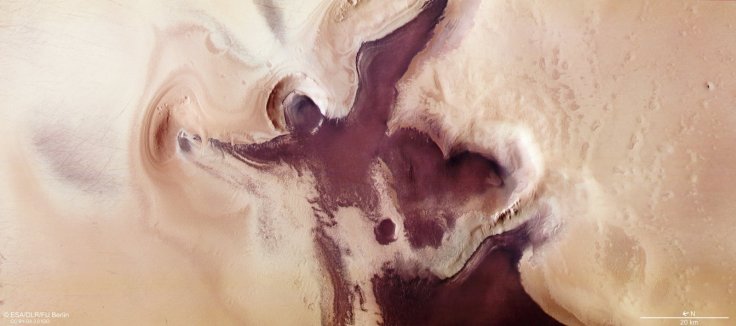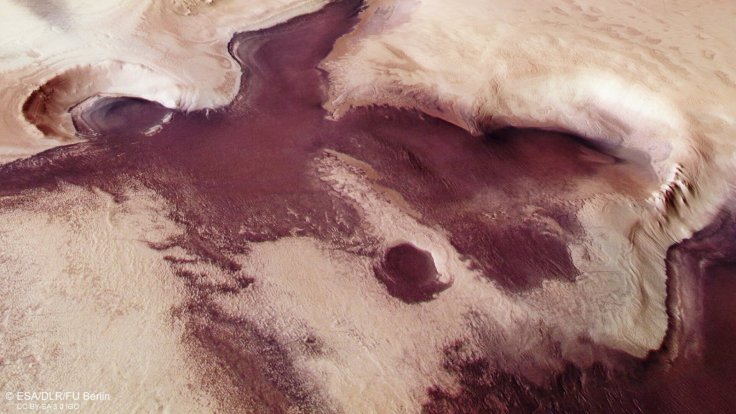The red planet is laden with geographic features that are both fascinating and mysterious. However, making nearly all discovered characteristics so far appear pale in comparison, the European Space Agency's (ESA) Mars Express mission has captured images of two astonishing silhouettes in the icy south pole of Mars—An angel with wings and a large heart beside it.
Captured by the Mars Express' High-Resolution Stereo Camera, an angelic figure—complete with wings and a halo, and a dark crimson-colored heart right next to it can be seen on the surface of Mars. The image, which also shows depleted stores of ice, seems befitting the festive season on its neighboring planet—Earth.
Icy Martian South Pole

The exquisite scenery was spotted in the south polar region of Mars, which ironically, is experiencing summer. Generally, the southern pole of Mars is encrusted with an ice cap that is about 400 km in length and 1.5 km thick.
Also, its volume amounts to roughly 1.6 million cubic kilometers. Of which, only a little of 12 percent comprises of water ice. However, with summer engulfing the southern hemisphere, the ice captured within the frame can be seen at its annual low.
Launched on 2 June 2013, Mars Express is the ESA's first planetary mission. It comprises of two sections—the Mars Express Orbiter and Beagle 2 Lander. With a flexible mission profile, it has had different missions added to its purpose over the years. Among its several contributions is the most recent discovery of signs of three brine ponds believed to be buried under ice. This was in addition to the larger underground reservoir located by the spacecraft in 2018.
An 'Angel' on Mars

Unmissable and distinct, the dark crimson coloration of the 'angel' and 'heart' can be owed to the chemical composition of the dune fields they are situated in. These fields are mostly constituted of sands that are abundant in two deeply crimson minerals—olivine and pyroxene—that lead to the formation of rocks and are found on Earth as well.
Both features contain several exciting characteristics in themselves. To begin with, the angel's 'hand', which appears to be reaching out to the left, is considered to be a massive sublimation pit. These pits are formed when ice is converted to gas, which in turn results in the formation of empty pockets and depressions on the Martian surface. Numerous sublimation pits can be seen spread across the surface to the right of the angelic figure.

The clearly distinguishable 'head' and 'halo' are the products of the ordeals faced by Mars' surface. They are drawn by an impact crater, where the numerous layers of deposits below the south pole's surface were exposed by the impact.
Matters of the 'Heart'

Last but not the least, the 'heart' is defined by a steep escarpment and differentiated from the massive swathe of dunes below it. Escarpments are chains of steep slopes or cliffs that are the outcome of erosive processes. While the origin of the dark material remains uncertain, it is believed that layers of it were encased within the surface after being formed by volcanic activity. However, continuous erosion and impacts led to its exposure, and it was spread across the planet by winds.
Additionally, the panorama also exhibits indications of dust devils; found in the deep-colored and cross-hatched pattern observed on the left side. Being a common feature on Mars, dust devils—which are strong whirlwinds of comparatively short duration—can lift and carry surface materials way. This leaves behind the dark and deep marks.









